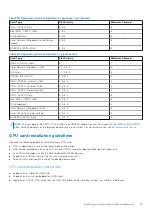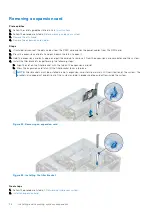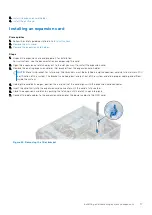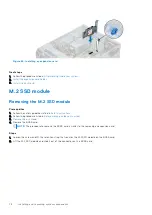
Table 16. Memory population rules
Processor
Configuration
Memory population
Memory population information
Single processor
Optimizer (Independent
channel) population order
1, 2, 3, 4, 5, 6, 7, 8, 9, 10
●
Populate in this order, odd
amount allowed.
●
Odd number of DIMM
population is allowed.
NOTE:
Odd number
of DIMMs will result
in unbalanced memory
configurations, which in
turn will result in
performance loss. It
is recommended to
populate all memory
channels identically with
identical DIMMs for best
performance.
●
Optimizer population order is
not traditional for 4 and 8
DIMM installations of single
processor.
○
For 4 DIMMs: A1, A2, A4, A5
○
For 8 DIMMs: A1, A2, A4,
A5, A7, A8, A9, A10
Mirror population order
{1, 2, 3, 4, 5, 6}
Mirroring is supported with 6
DIMM slots per processor.
Single rank sparing population
order
1, 2, 3, 4, 5, 6, 7, 8, 9, 10
Populate in this order, odd amount
allowed. Requires two ranks or
more per channel.
Multi rank sparing population
order
1, 2, 3, 4, 5, 6, 7, 8, 9, 10
Populate in this order, odd amount
allowed. Requires three ranks or
more per channel.
Dual processor
(Populate round
robin starting with
processor1)
Optimized (Independent
channel) population order
A{1}, B{1}, A{2}, B{2}, A{3},
B{3}...
●
Odd amount of DIMM slots per
processor allowed.
●
Odd number of DIMM
population is allowed.
NOTE:
Odd number
of DIMMs will result
in unbalanced memory
configurations, which in
turn will result in
performance loss. It
is recommended to
populate all memory
channels identically with
identical DIMMs for best
performance.
●
Optimizer population order is
not traditional for 8 and 14
DIMM installations of dual
processor.
○
For 8 DIMMs: A1, A2, A4,
A5, B1, B2, B4, B5
○
For 14 DIMMs: A1, A2, A4,
A5, A7, A8, A9, A10, B1, B2,
B3, B4, B5, B6
Installing and removing system components
67
















































